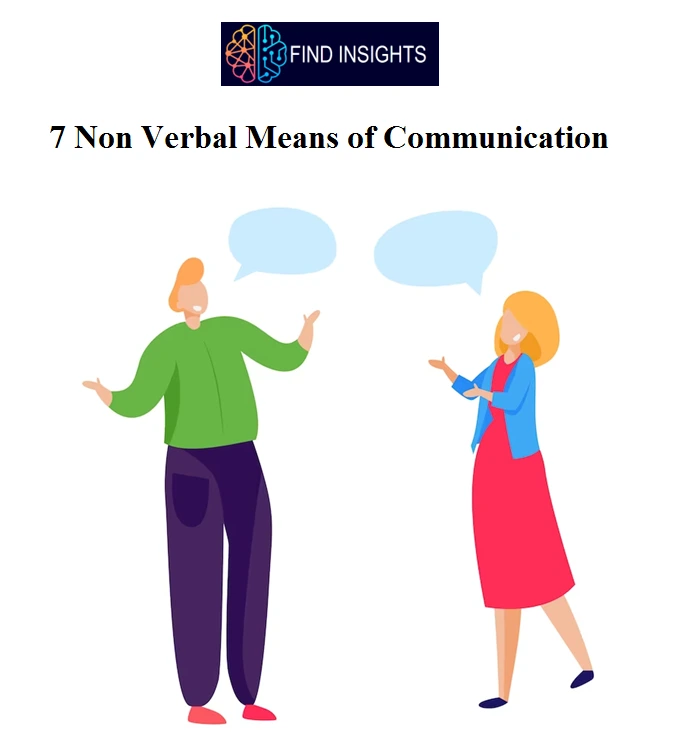
What are the Non Verbal Means of Communication?
A message can be sometimes expressed without the help of words. Non Verbal Means Of Communication is the process of communicating without the use of words. It is defined as non-word human responses like facial expressions and gestures and the perceived characteristics of the environment through which the human verbal and nonverbal messages are transmitted.
Nonverbal communication is also known as “silent language.” It involves the use of cues, gestures, vocal characteristics, facial expressions, and spatial relationship between the sender and the receiver to convey a message.
Example of Non Verbal Means of Communication:
- Smile
- Glance
- Stare or a frown convey different meanings.
Non Verbal Means of Communication:
The components of Non Verbal Communication are:
1. Kinesics
Kinesics is the interpretation of body language such as facial expressions and gestures or, more formally, non-verbal behavior related to movement, either of any part of the body or the body as a whole.
Body Language is technically known as kinesics Body language is the unconscious and conscious transmission and interpretation of feelings, attitudes, and also moods, through:
- body posture, movement, physical state, position and relationship to other bodies, objects and surroundings,
- facial expression and eye movement,
- and this transmission and interpretation can be quite different to the spoken words.
2. Proxemics
- It is the technical term for the personal space aspect of body language. Proxemics is the study of measurable distance between people as they interact.
- Body spacing and posture are unintentional reactions to sensory fluctuations or shifts, such as subtle changes in the sound and pitch of a person’s voice.
Social distance between people is reliably correlated with physical distance, as are intimate and personal distance, according to the following delineations:
- Intimate distance for embracing, touching or whispering
- Personal distance for interactions among good friends or family members
- Social distance for interactions among acquaintances
- Public distance used for public speaking
3. Oculesics:
- It is the study of the role of eye contact in non verbal communication. Our eyes are a very significant aspect of the non-verbal signals we send to others.
- Oculesics is one form of nonverbal communication, which is the transmission and reception of meaning between communicators without the use of words.
- It can include the environment around the communicators, the physical attributes or characteristics of the communicators, and also the behavior of the communicators
4. Chronemics:
- It is the study of the use of time in nonverbal Communication. The way we perceive time, structure our time and react to time is a powerful communication tool, and also helps set the stage for the communication process.
- Across cultures, time perception plays a large role in the nonverbal communication process. Time perceptions include punctuality, willingness to wait, and interactions.
- The use of time can affect lifestyles, daily agendas, speed of speech, movements and also how long people are willing to listen.
5. Haptics:
- It refers to the study of touching. There is six different kinds of touch. These include: positive, playful, control, ritualistic, task-related and also unintentional.
- Managers should know the effectiveness of using touch while communicating to subordinates, but need to be cautious and understand how touch can be misunderstood.
- Working with others and using touch to communicate, a manager needs to be aware of each person’s touch tolerance.
6. Paralinguistics:
- It is the study of variations in pitch, speed, volume, and pauses to convey meaning. Interestingly, when the speaker is making a presentation and is looking for a response, he will pause.
- However, when no response is desired, he will talk faster with minimal pause.
7. Paralanguage
It refers to the non-verbal elements of communication used to modify meaning and convey emotion. Paralanguage may be expressed consciously or unconsciously, and also it includes the pitch, volume, and, in some cases, intonation of speech. Sometimes the definition is restricted to vocally produced sounds. The study is known as paralinguistics
How to understand Non Verbal Means Of Communication?
The following guidelines can help individuals understand Non Verbal Means Of Communication better:
1. Observe keenly what is happening:
When nonverbal behaviour involves an emotional response (for example, tears rolling down the cheeks or eyes becoming red), it clearly conveys the message to the other person.
2. Consider the differences between verbal statements and nonverbal behaviour:
If there is a discrepancy between what a person says and what his body language indicates, then the situation should be studied closely. It is believed that actions are more accurate than words. 3. Look for subtleties in nonverbal behavior: Through careful observation, one can differentiate between a fake action and also a genuine action. For instance, a sarcastic smile can be differentiated from a genuine one.
LIKE WHAT YOU’RE READING?
CHECK OUT SOME OF OUR OTHER GREAT CONTENT HERE
- THE ART OF PUBLIC SPEAKING (STEP BY STEP GUIDE)
- HOW TO IMPROVE COMMUNICATION SKILLS?
- PROFESSIONAL & BUSINESS COMMUNICATION
- TOP SKILLS EVERY ENTREPRENEUR SHOULD HAVE
- PERSONALITY DEVELOPMENT TIPS
- WHAT IS A WRITTEN COMMUNICATION
- LEARN THE ART OF LEADERSHIP SKILLS
- LEARN THE ART OF NEGOTIATION
- 6 Effective Elements of the Communication
- WHAT ARE THE OBJECTIVES OF COMMUNICATION?
- 7 EFFECTIVE PRINCIPLES OF COMMUNICATION
- 12 BEST TIPS TO OVERCOME BARRIERS FOR EFFECTIVE COMMUNICATION
- 5 BEST ENGLISH BOOKS FOR GRAMMAR
- WHAT ARE THE INTERPERSONAL SKILLS ? 6 TIPS TO DEVELOP IT!




6 Comments